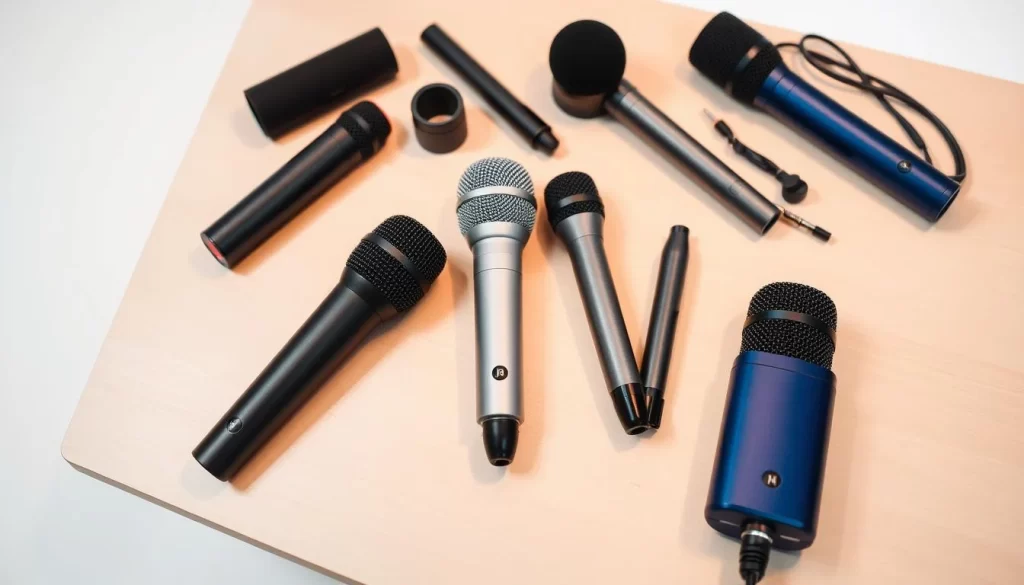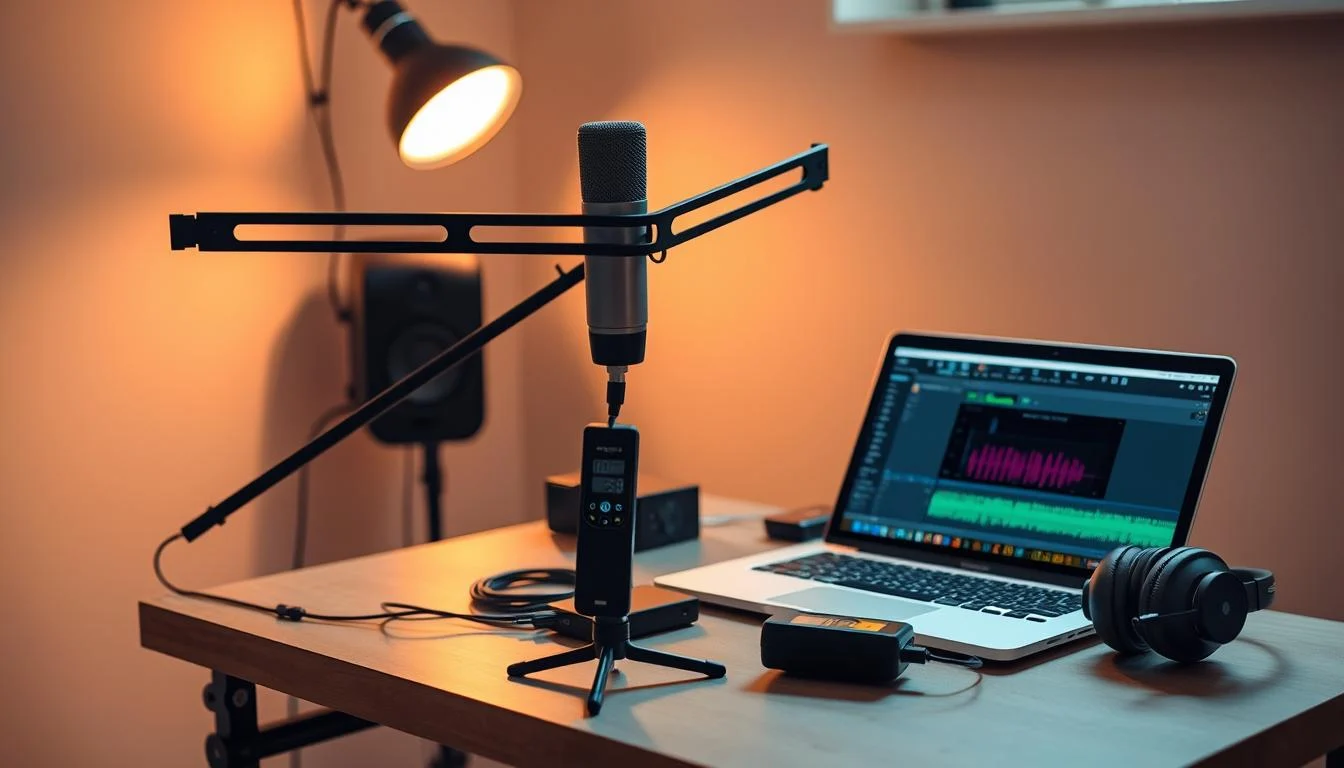Gone are the days when high-quality audio production required bulky studio setups. Today, creators can capture crisp, professional sound from anywhere—whether in a coffee shop, park, or even while traveling. I’ve personally switched from fixed recording spaces to flexible setups, and the difference is game-changing.
Modern tools like USB microphones and smartphone apps now rival traditional studio gear. For example, Riverside’s mobile app and Zoom’s H4N recorder deliver studio-grade results without the hassle. The freedom to record anytime, anywhere, opens new creative possibilities.
In this guide, I’ll share essential tips, gear recommendations, and software picks to help you achieve flawless audio on the move. Whether you’re a seasoned host or just starting, mobile setups make recording simpler and more accessible.
Key Takeaways
- Portable setups now match studio-quality audio.
- USB mics and smartphone apps streamline recording.
- Flexible solutions let you create content anywhere.
- Tools like Riverside and Zoom H4N are pro favorites.
- Mobile recording saves time and expands creative options.
Why Mobile Podcasting Is the Future of Audio Content
The way we create audio content has transformed dramatically in recent years. No longer tied to bulky gear, creators now prioritize portability without sacrificing sound clarity. A staggering 72% of producers say flexibility matters more than traditional setups.
The Rise of On-the-Go Content Creation
Demand for mobile production grew 40% last year, per Riverside’s 2024 report. Take tech host Stephen Robles—he records *Primary Technology* using just an iPhone and a Rode Lavalier II mic. Even NPR journalists rely on Zoom’s PodTrak P4 for field interviews.
Benefits of a Portable Setup
Ditch the $200/hour studio rental. Mobile kits eliminate overhead while offering:
- Spontaneity: Capture ideas anytime, anywhere.
- Cost savings: No long-term leases or expensive gear.
- Guest flexibility: Riverside’s async feature lets remote guests join effortlessly.
Professional Quality Without the Studio
Modern tools blur the line between mobile and studio quality. USB mics and apps like Riverside deliver crisp audio, proving you don’t need four walls to sound polished. As one producer told me, “Freedom fuels creativity.”
Essential Gear for Quality Recordings
Recording crisp audio no longer means being chained to a desk—today’s best setups fit in your backpack. Whether you’re using a smartphone, laptop, or dedicated recorder, the right tools make all the difference. Here’s what I swear by for pro-level sound on the move.
Choosing Your Recording Device
Smartphones like the iPhone 14 Pro Max surprise with their built-in mics, especially when paired with apps like Riverside. For deeper editing, laptops like the MacBook Air handle Logic Pro smoothly. But if you need standalone reliability, the Zoom H4N recorder is my go-to.
Compact Mics for Clear Sound
Size doesn’t dictate quality. USB mics like the Apogee HypeMiC plug directly into phones, while XLR options like the Shure MV7+ work with portable audio interfaces. For interviews, the Rode Lavalier II stays nearly invisible yet delivers rich vocals.
Accessories You’ll Actually Use
Stability matters. A Manfrotto tripod keeps your setup steady, and Rycote stickies reduce handling noise. Don’t skip a windshield—even a breeze can ruin takes. My travel kit? Zoom H4N + Sennheiser MKE 400 + a collapsible reflector for quick sound treatment.
“A $15 windshield saved my outdoor recording when a $200 mic couldn’t.”
Pair these with closed-back headphones (like Audio-Technica ATH-M50x) to monitor audio clearly, even in noisy cafés. With this gear, you’re ready to record anywhere—no studio required.
Choosing the Right Mobile Recording Device
Your recording device can make or break your audio quality—choose wisely. Whether you’re interviewing guests or capturing solo episodes, the right tool ensures clarity even in noisy environments. Let’s compare smartphones, laptops, and dedicated recorders.
Smartphones: Convenience vs. Compromise
Your phone is always handy, but it has limits. Built-in mics often compress files, muddying your audio. Apps like Riverside help, but they can’t match a laptop’s WAV format for editing flexibility.
Battery life matters too. For field work, aim for 6+ hours. Pro tip: Use a lavalier mic to bypass the phone’s weaker internal mic.
Laptops: Power in Your Backpack
A computer unlocks pro editing, but not all are equal. Look for Thunderbolt 4 ports and SSD storage. The Focusrite Scarlett 2i2 interface pairs perfectly for multi-mic setups.
MacBooks handle Logic Pro well, while Windows laptops with Audacity offer budget-friendly options. Just remember: Laptops aren’t as discreet for street interviews.
Dedicated Recorders: Unstoppable Quality
The Zoom H4N survives extremes—I recorded 3-hour interviews in rainforest humidity without a hiccup. Its 24-bit/96kHz WAV files are studio-ready, and four-track recording lets you isolate voices.
At $249, it’s cheaper than a Rodecaster Pro II but outperforms phones in raw audio capture. Perfect for documentary-style projects.
“My Zoom H4N survived a sandstorm. My iPhone didn’t.”
Microphones That Travel Well
Great sound shouldn’t weigh you down—these compact microphones prove it. Whether you’re recording in a café or a campground, the right mic ensures clarity without bulk. I’ve tested dozens to find the best balance of portability and performance.

USB Mics for Plug-and-Play Simplicity
Need a no-fuss solution? USB mics like the Apogee HypeMiC ($349) connect directly to phones or laptops. Compared to budget options like the Samson Go ($45), its noise floor is whisper-quiet—perfect for busy environments.
XLR Mics With Portable Interfaces
For pro-level control, pair an XLR mic like the Shure MV7+ with a compact interface. I use the Sennheiser MKE 400 and Zoom PodTrak P4 for field interviews. The dual XLR/USB-C design offers flexibility when switching devices.
Lavalier Mics for Ultimate Mobility
The Rode Lavalier II (20Hz–20kHz response) clips discreetly to clothing. Experiment with placement: *lapel* for natural tone, *tie clip* for speeches, or *hidden mounts* for stealth recordings. Just add a Rycote windshield—DIY foam can’t match its wind-blocking power.
“I ditched condenser mics after a windy beach episode ruined my takes. Now, my dynamic Shure SM7B handles anything.”
Portable Audio Interfaces and Mixers
Compact audio interfaces bridge the gap between studio and mobile recording. I’ve tested dozens of units to find gear that delivers pro sound without the bulk. The right audio interface transforms your smartphone or laptop into a powerful recording station.
Focusrite Scarlett 2i2: The Gold Standard
The 4th-gen Scarlett 2i2 remains my top pick for mobile setups. Its two XLR inputs handle dynamic mics perfectly, while 24-bit/192kHz recording captures every detail. I use it for:
- Gain staging with two guests (keep levels at -12dB for headroom)
- Direct monitoring via USB-C for zero-latency recording
- Field interviews with the optional iRig Pre 2 for phantom power
All-in-One Power: Rodecaster Pro II
When I need to record four remote guests simultaneously, the Rodecaster Pro II shines. Pat Flynn’s team uses its Bluetooth connectivity for wireless interviews. The touchscreen simplifies mixing, and built-in effects eliminate post-production hassles.
| Feature | Focusrite Scarlett 2i2 | Rodecaster Pro II |
|---|---|---|
| Inputs | 2 XLR/TRS | 4 XLR + Bluetooth |
| Max Sample Rate | 192kHz | 48kHz |
| Battery Life | N/A (USB powered) | 5 hours |
| Best For | Mobile interviews | Multi-guest recordings |
“My Scarlett survived six months in my backpack across three continents. That’s reliability you can’t fake.”
Essential Interface Maintenance
Keep your gear performing flawlessly with these tips:
- Clean XLR ports monthly with compressed air
- Update firmware before major projects
- Use a Pelican 1050 case for travel protection
- Test all inputs before remote recordings
Monitoring Your Audio on the Go
Clear audio monitoring is just as crucial as recording when you’re working remotely. I’ve learned the hard way that background noise or technical glitches often go unnoticed until playback. With the right tools and techniques, you can catch issues immediately.
Best Headphones for Mobile Work
The Beyerdynamic DT 700 Pro X offers 35dB noise isolation—perfect for busy locations. For flatter response curves, the Audio-Technica M30x reveals every detail in your recordings.
ANC models like Bose QC35 II help in loud spaces, but can mask subtle audio flaws. My travel pair? Sennheiser HD 280 Pro (32dB) with replaceable cables—they’ve survived three years of daily use.
Setting Proper Audio Levels Anywhere
Watch those waveforms! I keep peaks at -6dB in Riverside’s app for editing headroom. Hardware VU meters help when software monitoring isn’t available.
For voice work, aim for consistent -12dB averages. Pro tip: Record 30 seconds of ambient noise first—it helps with noise reduction later.
Troubleshooting Common Monitoring Issues
Hissing often means ground loops—try a $15 isolator. Latency? Enable direct monitoring on your interface. Phase problems usually stem from multiple mics too close together.
Protect your hearing: I never monitor above 85dB during long sessions. The $40 Panasonic Ergofit works surprisingly well with custom EQ adjustments when budget’s tight.
“My DT 700 Pros caught a failing mic preamp before it ruined an entire interview series.”
Mobile Recording Software and Apps
Quality recording apps now deliver studio-level results from your pocket. I’ve tested dozens of solutions—the best ones handle everything from multi-track recording to AI-powered editing. Whether you’re using iOS, Android, or laptops, there’s perfect software for your workflow.
Smartphone Solutions That Impress
Riverside.fm stands out with unlimited 48kHz recordings and separate voice tracks. Compared to Anchor’s 2-hour limit or GarageBand’s iOS exclusivity, it’s my top pick for serious creators.
The mobile app version keeps all desktop features like 4K video sync. For quick edits, its AI transcription saves hours of manual work.
Desktop Powerhouses for Laptops
Audacity remains the free champion, but Hindenburg Pro ($399) offers smarter workflows. Adobe Audition ($21/month) wins for video integration—I use it when editing podcast episodes with B-roll.
Pro tip: Always record WAV files for editing flexibility. MP3s may save space but lose critical audio data.
Cloud Platforms Changing the Game
Riverside’s browser-based studio handled my 12-interview marathon at CES flawlessly. The auto-backup to cloud storage prevented potential disasters when my laptop crashed.
Other standout features:
- AI noise removal (better than Descript’s Studio Sound for vocal clarity)
- File naming presets like S01E03_RAW for organization
- Real-time remote guest connections without downloads
“Switching to Riverside saved 8 hours/month in post-production—that’s an entire workday!”
Pair these tools with proper file management, and you’ll spend less time troubleshooting and more time creating. My system: Weekly backups to Dropbox plus local SSD copies for active projects.
Conclusion: Your Mobile Podcast Studio Awaits
You don’t need a fancy setup to create pro-level audio—just the right tools. A $500 kit (smartphone + Riverside app + lavalier mic) rivals $2,000 rigs. I’ve seen hosts like *The Mobile Journalist* hit 50k downloads with similar gear.
Before you hit record: Test your setup in real environments. Pack backup cables and a power bank. Always monitor levels to avoid clipping.
Start small. Use what you have, then expand. Share your journey with #PodcastNomad—I’d love to see how you record podcast episodes on the go!
